Tropfest is the world’s largest film festival, with 130,000 people attending to watch 16 finalists in one of the world’s most popular short film festivals. The rules are simple. First, it must be contain this years signature item (this year an umbrella). Second, it must be less than 7 mins. Finally, the film must premiere at Tropfest and cannot have been shown previously anywhere.
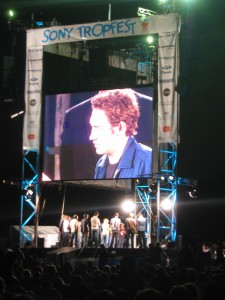
Tropfest this year had a record breaking number of entries, 792 original films made and submitted for the world’s largest short film festival held annually in Australia. On hand to judge this year’s entries were Oscar winner Geoffrey Rush, Xmen and up coming Superman director Bryan Singer, amongst others. The judging criteria is “vision, originality and basic story-telling skill”. While the main event is held in Sydney with over 90,000 in attendence for the free outdoor event, it is also watched simultaneously in Melbourne, Brisbane, Canberra, Hobart and Perth. The event has been running for 13 years and last night even had its first streaker !
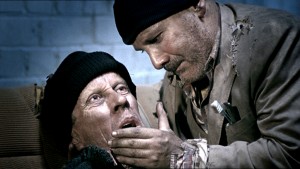
The winner this year was Australian Summer. It is a beautiful film about two homeless people “who escape their situation by the power of storytelling,” explains director Luke Eve. Luke had been working in TVC’s and a few years ago stopped producing and returned to film school. Eve directed and produced the award winning film. The brilliant dialogue and acting driven work also earned its two leading actors, Arky Michael & Bruce Spence, a joint Best Actor award on the night and great praise from the cheering crowd.
The runner-up film was “Lucky”, a film discribed by director and star of the film Nash Edgerton as a film which shows that “sometimes when you’re in trouble – you are actually f*cked no matter what you do”. Fxguide went behind Lucky and followed it from script to the final awards last night. The action/ stunt film with ‘one joke’ was shot in northern rural NSW just before Xmas.
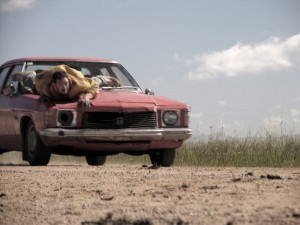
In the film we find our hero trapped – perhaps underground – or at it turns out he is bound in the trunk of a speeding car. A car which is shooting down a rural road with a brick on the accelerator and no driver. Our hero struggles to escape – only to finally succeed in breaking into the drivers seat, eventually stopping the car and then, in a surprise ending, dying anyway as the car explodes with a booby trap.
The post-production and visual effects supervsion for Lucky were provided by InCase – a new company established by Fxguide’s own Mike Seymour and well known Australian Post production advisor David Edgar. Seymour explains that InCase has been established to offer professional services to the film and TV industry, including high level project consulting and also training courses through fxguide – such as the fxguide live seminars this April at NAB.
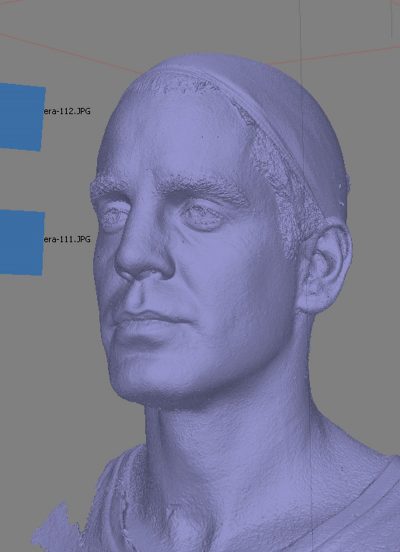
InCase’s first project was Edgerton’s short film, shot on location in central northern NSW. The film is packed with stunts and effects and builds on Edgerton’s own impressive career not only as a director but one of Australia’s leading stuntmen.
Nash stars in the film and does his own stunts, something he is familiar with after working as Obi-Wan Kenobi’s stunt double in the latest Star Wars prequels. All visual effects and online for the film were provided by InCase, using a mix of Apple Shake and Discreet Flame gear provided in roadcases.
Effects for the film included numerous sky replacements matching footage shot over two very different day light exteriors, wire removal for some of the dangerous stunt work, matte painting and work on the final explosive ending of the film. “It’s great being able to offer a production exactly what they need and be independent and flexible enough to respond to a bunch of unexpected effects that resulted from the large scale car explosion shots” explains Seymour.
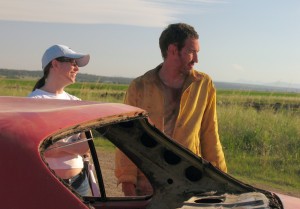
The three camera shoot was undertaken by Nash’s company Blue Tongue films, produced by Brooke Wilson and filmed by DOP Greig Fraser. While Nash did his own stunts from a moving car often at very high speeds, safety wires were needed to be removed in some shots. Lucky required advanced sky keying and tracking, rig removal and the new 55mm spark plug ins were used extensively. “55mm provides non-gimmicky photographic looks,” explains Syemour. ” Nash wanted a sort of bleech by-pass look – and we would have the 55mm spark in the batch tree to check the graded look – even knowing that the final film would have a data -‘tape to tape’ grade. 55mm are the most exciting sparks I’ve seen in ages just because they are likely to be used a lot and they are not eye candy but serious tools” points out Seymour.
The film was offline edited by Nash Edgerton and Luke Doolan. After telecine it was finished 16:9 with the possibility of moving on to a full film finish, so all the film is shot 2.35:1.
The most complex shot was actually the final car explosion. The scene was shot with three cameras, with the film’s hero in place for the first pass and then he stepped out for the actual explosion. It was always planned that in post the hero would be seen in the actual fireball.
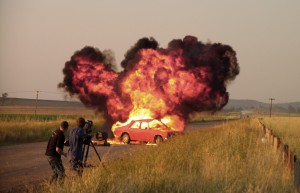
The shot was complex because:
* The crew needed to remove all the glass, seats, and fixtures from the car – for safety reasons – so all of these needed to be composited back for the blast.
* Unbelievably the first firing of the explosives failed to ignite the petrol, but associated blasts bent the car out of shape. This broke the “locked off camera”.
* The light was failing with the sun setting. So the surrounding countryside was no longer in sunlight. In fact, it read as post-sunset – quite dark on film.
* On the second real firing of the explosives, the DOP suddenly pulled out to a much wider shot on the zoom lens of Camera 3 to frame a beautiful wide shot of the burning car and its huge fire ball. This created problems as there was no full sun matching shot of this new very wide angle shot… and of course the Editor and Director both fell in love with the new wide angle end shot.
* In the wide final shot the flames had started to decrease in size – and the director wanted the flames greatly increased in size.
To solve these problems a matte painting was created of the wide shot including a new road covering safety crew, other cameras and adding a moving wheat field beside the road. Another take of the explosion was composited on top of the car in the wide shot to increase the flames. “Wur team used flame’s Modular keyer with the ColourWarper(CW) node as a keyer to key the black smoke off the very dark sky behind and add it all back into the final shot. It was one heck of a MK setup”, jokes Seymour. “The CW keyer uses a very sharp diamond key shape allowing for high accuracy at low light, low chroma levels”.
 The driverless car was achieved by having stunt driver Tony Lynch – dressed as a car seat – take the place of the real driver’s seat. There was some adjustment in terms of shape and size in post-production to make it appear normal. Experienced stunt driving was vital since the safety of the director/star relied on accurate driving and especially precise acceleration and deceleration.
The driverless car was achieved by having stunt driver Tony Lynch – dressed as a car seat – take the place of the real driver’s seat. There was some adjustment in terms of shape and size in post-production to make it appear normal. Experienced stunt driving was vital since the safety of the director/star relied on accurate driving and especially precise acceleration and deceleration.
The launch of InCase comes in response to the growing move towards freelance operation in the post and VFX industry. This has followed the long running trend towards freelance producers and creatives at advertising agencies and of course in production before that where DOPs, production designers and most crew are freelance.
While 3D animators often take the freelance route, especially in feature film production where permanent staff positions are extremely rare, Flame 2D compositors rarely freelanced. Few facilites want to dry hire or “4 wall” although this practice is much more common in some large North Amercian cities. Furthermore, traditional Flame suites are just too bulky to roadcase and make movable. With recent moves to LINUX this has changed. Of course with compositing products such as Shake, it is entirely feasible to take very complex “suites” anywhere.
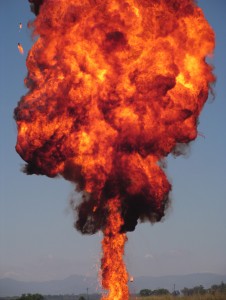 “All this means that a visual effect supervisor or effects producer can now put together a one week or 6 month team for visual effects complete with high speed render farms, networking with international private fibre and gear without mortgaging the house or having to commit to equipment that might not be needed in the next ecomonic downturn or quiet patch” says Seymour.
“All this means that a visual effect supervisor or effects producer can now put together a one week or 6 month team for visual effects complete with high speed render farms, networking with international private fibre and gear without mortgaging the house or having to commit to equipment that might not be needed in the next ecomonic downturn or quiet patch” says Seymour.
In the case of “lucky” a temp unit was put together for the film which moved on to other projects after post-production was completed. “People want advice to help them produce their projects – backed by the resouces to pull it off” added Seymour.
The film was actually finished a week before the festival deadline, which was very timely as key members of the crew were dragged on to new project around the time of the actual deadline. Along with 792 other films Lucky was judged and selected as a Finalist. There was one crew screening in private a few weeks before the night. Other than that, the film debuted as the sixth film of sixteen and was very well received by the crowd, most of whom fell for the ‘false ending’ and cheered as our hero exploded and the credits rolled.
(For those checking: the umbrella was in the trunk of the car beside the hero’s tied up feet.)
